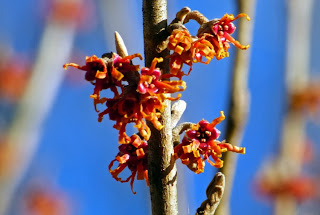 |
| Earth Measures Sculpture |
I have filled feeders for my backyard birds for many years. More Starlings and House Sparrows eat my seed than any other birds. But I don't mind, since other cute backyard birds come to visit too. Today, fighting a severe case of cabin fever, I joined Dick on a snowy trip to
Bernheim Forest and Arboretum. While he made copies for a presentation this weekend, I bundled up and went birding. I've never been to Bernheim in the snow before, and it was absolutely beautiful.
 |
| Northern Cardinal - female |
The Education Building has a warm room looking out on the bird feeders. This time of year, many familiar birds, and some I rarely see, come for a snack. Cardinals are very common, of course.
 |
| Northern Cardinal - male |
 |
| Carolina Chickadee |
As are Carolina Chickadees and Carolina Wrens.
 |
| Carolina Wren |
 |
| Eastern Towhee |
While I tried to distinguish one LBJ from another, a bright orange and black bird hopped into the brush. Every time I moved from one place to another in the bird room, all the birds took off for a convenient branch, but they soon resumed feeding.
 |
| Goldfinch |
Goldfinches positively refuse to come to my yard, unless the zinnias are blooming. But these little guys in winter plumage ate anything they found around the feeders at Bernheim.
 |
| Red-bellied Woodpecker |
The Red-bellied Woodpecker is a very polite bird at the feeder. He quietly approaches the seed on the ground, chooses one piece, and retreats to the branches to eat it. You can just see the red wash on his belly in this photo.
 |
| Yellow-bellied Sapsucker |
After lunch, we thought we heard a hawk, and walked out looking for it. A small bird landed on the tree trunk and started walking up the bark. It called again, and we knew the sound belonged to a Yellow-bellied Sapsucker! I'd never heard one call before!
 |
| Song Sparrow |
Now, I'm pretty comfortable with the more common birds, but Sparrows, the LBJ's in the world, can be my downfall. As I watched all the birds, I identified several little sparrows, including the ever present Song Sparrow, with his stripped belly and brown thumb-print.
 |
| White-throated Sparrow |
The White-throated Sparrow is a winter visitor in Kentucky, with two different color morphs - the crisp black and white head stripes, or the tan and black head stripes. I sometimes think the black and white is a White Crowned Sparrow, but the yellow spots by the eyes and white throat patch are distinctive, of course. I love to hear this little guy calling "Oh Sam Peabody, Peabody."
 |
| Fox Sparrow |
OK, I'm good with the Song and White-throat. Yikes, what is this bright rusty tailed bird with gray on the head and nape? Curiously, it scratched not with one foot at a time, but by hopping and scratching the ground at the same time! Larger than the others, this must be the Fox Sparrow, and there were at least ten of them on the ground. Another winter visitor, unsuccessfully trying to evade the cold northern winter this year.
 |
| American Tree Sparrow |
Another different sparrow - rufous crown, but not a Chippy. Gray breast with a dark spot, and finally, a two-toned bill - dark on top and yellow on the bottom. It's an American Tree Sparrow! Not a lifer for me, but one I don't often see. And one I was very pleased to identify on my own!
 |
| Fox Sparrow, American Tree Sparrow and White-throated Sparrow |
On a day when the high temp was 12 degrees in the sun, how wonderful it is to sit in a warm room, watching feeders filled by someone else, and seeing new birds that never visit my house! As I write this blog post, my favorite movie,
The Big Year, plays on TV. I'll never go for a big year, of course, but I'm always excited to see and identify an unusual bird all on my own!































